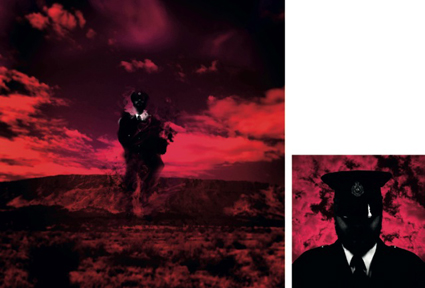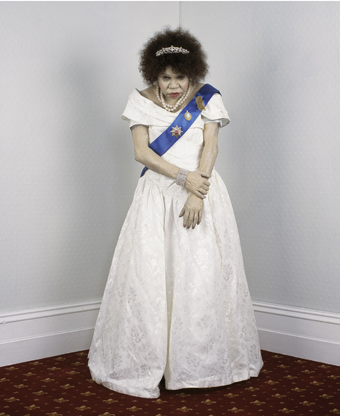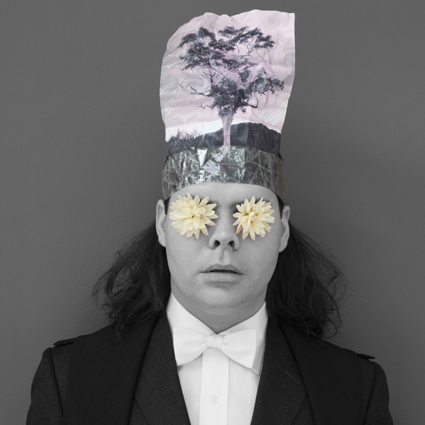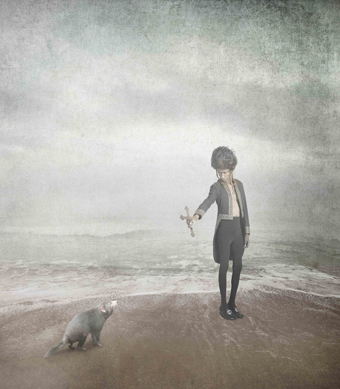Bewitching disorientations
Virginia Baxter, Debil Debil

Warwick Thornton
In Warwick Thornton’s blood red pigment prints, three looming figures—a policeman, a priest and a stockman (indiscernibly black or white)—hover above the landscape as if at any moment they might either ascend to the heavens or bring down their wrath (Untitled, 2013).

Darren Siwes, Northie Kwin, 2013
courtesy the artist and Greenaway Art Gallery
Darren Siwes, Northie Kwin, 2013
On the adjacent wall, in his latest photographic series, Mulaga Gudjerie (2013), Darren Siwes’ Indigenous subjects are caked in white greasepaint, ostensibly dressed as a British Queen and her Consort. Their poses are in turn imperious, hostile, formal or put-upon. Like other works in this exhibition, Siwes’ images are disturbing in their ambiguity, simultaneously projecting a shifting hierarchy, mocking monarchy and its trappings and reminding us of the imposed costuming of some 19th century Indigenous portraiture. In the room notes Siwes writes, “I see my work residing somewhere between the truth and a hypothetical.”
The large white room of the Anna Schwartz Gallery is full of such crossovers between this world and its others. In r e a’s photographic triptych Poles Apart (2009), we see the artist, dressed in a black crinoline, running as if pursued (an image more explicit in the associated video not on show here) through a landscape beloved of the Heidelberg School. She blurs and vanishes into her surroundings. In strange juxtaposition Danie Mellor’s native hunters (Bayi Minyjirral, 2013) move through a rainforest rendered in the blue and white of willow pattern, their landscape made alien.

Christian Thompson, Desert Melon, 2012
courtesy the artist and Gallery Gabrielle Pizzi
Christian Thompson, Desert Melon, 2012
The ever-evolving Christian Thompson conjures another impressive series of shape-shifting self-portraits covering his eyes not with pennies as in death but with shells, flowers and fruit: his own body an unlimited palette for projection. There’s more ambiguity in Destiny Deacon’s inkjet prints of gleeful adolescents enthusiastically embracing Western depictions of vampirism and trying them on for size (Blakula Series, 2011).

Michael Cook, Civilised #10, 2012
courtesy the artist and Dianne Tanzer Gallery + Projects
Michael Cook, Civilised #10, 2012
We’ve seen parts of Michael Cook’s haunting work Civilised (2012) but never all 14 images in the series presented so generously here. There’s a disconcerting aura of surrealism in these graceful, dream-like photographic collages featuring lone subjects on a misty shoreline wearing costumes ranging from Elizabethan to Victorian. We’re reminded of all manner of invasion and in particular the imposition of European culture on indigenous peoples but, save for one woman drowned, far from appearing abject, Cook’s subjects maintain their customary bearing in the face of our disorientation, one man confidently wielding a cross to ward off a Tasmanian devil.
Sharing the entrance to the exhibition with the bronze Mokuy (2011) of Nawurapu Wunungmurra is Tracey Moffatt’s film beDevil (1993), its three gothic tales filmed in saturated colour dealing with death and disappearance, and everyday spirits who refuse to leave. Curator Marcia Langton reflects, “When Debil Debil opens it will be 20 years since beDevil first screened in Australia. It was a revolutionary work of cinematic art. Its presence in this exhibition marks a point in our history. Since then, conceptual art work that tackles difficult matters of history and the self has flourished” (Room Notes).
Debil Debil is a thoroughly engrossing exhibition, bringing together some of the most skilful artists of this inventive era.
Debil Debil, curator Professor Marcia Langton (AM), artists Brook Andrew, Daniel Boyd, Gordon Bennett, Michael Cook, Destiny Deacon, Ricardo Idagi, Danie Mellor, Tracey Moffatt, r e a, Darren Siwes, Christian Thompson, Warwick Thornton, Nawurapu Wunungmurra, Anna Schwartz Gallery, Carriageworks, Sydney, 20 April-8 June
RealTime issue #115 June-July 2013 pg. 52-553






